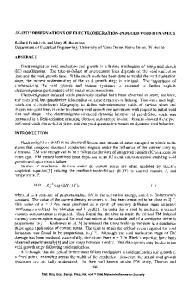Void Evolution via Coupled Creep, Diffusion and Electromigration in Confined Nano-interconnects
- PDF / 262,208 Bytes
- 5 Pages / 612 x 792 pts (letter) Page_size
- 90 Downloads / 257 Views
0978-GG05-13
Void Evolution via Coupled Creep, Diffusion and Electromigration in Confined Nanointerconnects Dongchoul Kim and Wei Lu Mechanical Engineering, University of Michigan, Ann Arbor, MI, 48109 ABSTRACT A three dimensional electromigration model is presented to account for void evolution in small scale interconnects. The model provides better understanding of the evolution process by considering concurrent kinetics of creep flow and surface diffusion. The multiple kinetics and energetics are incorporated into a diffusive interface model. Simulations show that a shape stable in surface diffusion can become unstable in a creep dominated process, which leads to a quite different void morphology. INTRODUCTION Void morphological evolution and its implication for electromigration induced failure have been studied based on diffusion as a mass transport mechanism and extensive understandings of it have been accumulated [1-3]. The recent miniaturization of integrate circuits demanded more precise insights into electromigration in small scale interconnects and it is suggested that creep can play an important role due to increased electric current density and elevated temperature [4, 5]. Here, we study void evolution driven by electromigration in a small scale interconnect by considering concurrent kinetics of surface diffusion and creep flow. We aim to reveal the dynamic void evolution process in interconnects by studying the interplay of the electron wind, surface energy, surface diffusion and creep. A three-dimensional model capable to describe the rich dynamics is developed in this paper, which can provide more realistic simulation beyond existing two-dimensional diffusion models. To overcome the computational complexity due to evolving interfaces, multiple energetics and kinetics, a diffuse interface approach which has shown its reliability and effectiveness in previous study [6] is adopted. Performed simulations show distinctive morphologies of void depending on different dominating kinetics and suggest the necessity of coupled mechanism for better understanding of electromigration. MODEL We consider the migration and morphology evolution of a small void that has already nucleated. The material surrounding the line is assumed to be much stiffer than aluminum. A coordinate system is attached so that the x1 − x2 plane coincides with the bottom of the interconnect line. Define a concentration C by the volume fraction of metal, C = 0 for void and C = 1 for metal. Regard the concentration as a spatially continuous and time-dependent function C ( x1 , x2 , x3 , t ) . We consider regions away from any possible grain boundary in the metal line (such as the bamboo structure) so that the only mass transport mechanism is surface diffusion and creep flow. For simplicity, we assume isotropic surface energy and diffusivity.
The electron wind exerts a force, Fe , in the direction of the electron flow at the void surface. The force on a per unit volume basis is given by Fe = − N a Z ∗ e E , where Na is the number of atoms per
Data Loading...











